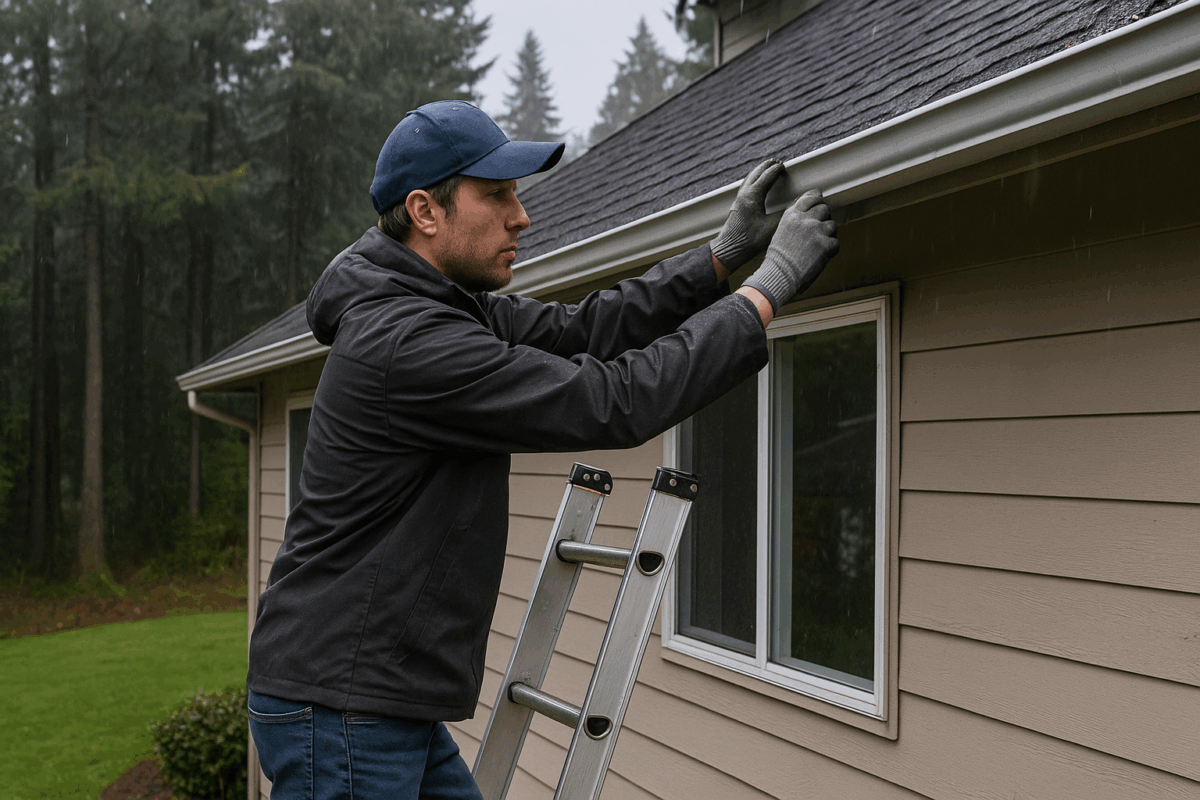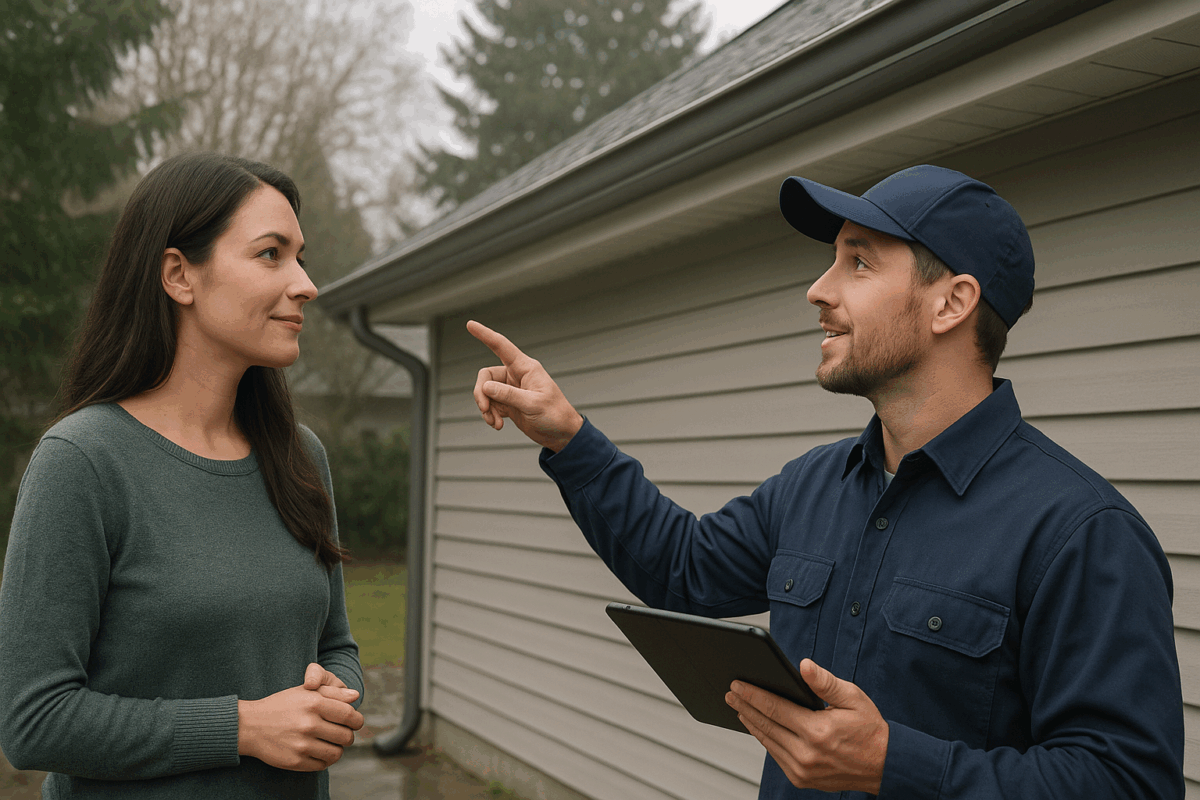If you live in Washington, you’re used to wet weather. Rain is part of daily life here, whether it’s a drizzle or a full-on downpour. The thing is, all that water must go somewhere, and that’s where your gutters come in. They quietly handle gallons of runoff during every storm, guiding it away from your roof, walls, and foundation.
However, just because your gutters look okay from the ground doesn’t mean they’re doing their job. A surprising number of people assume a quick cleaning is enough, or they try to patch leaks with whatever they have on hand, usually duct tape. Unfortunately, these assumptions can lead to some serious headaches.
This post addresses three of the most common myths about rain gutter repair, particularly for homeowners in Washington. We’ll also explain why ignoring small issues can lead to big and expensive problems and why bringing in the pros makes a real difference.
The Hidden Costs of Ignoring Small Repairs
Perhaps it begins with a loose bracket or a downspout that detaches after a windy day. These little things are easy to brush off.
When gutters sag or leak, water doesn’t drain properly. Instead of flowing away, it spills over the edge, seeps into the soil, and puts pressure on your foundation. You might not notice right away, but eventually, you’ll see cracks in the concrete or water spots creeping up the basement walls.
Seattle Public Utilities recommends directing gutter water at least five feet away from your home, and ten feet is even better. That might sound like overkill, but with the amount of rainfall we get, it’s necessary. One misaligned gutter can send thousands of gallons of water straight to your home’s base over time.
Then there’s safety. Climbing ladders to deal with clogs or leaks might seem like a money-saver, but the CDC continues to report high injury rates from DIY maintenance jobs. It’s not just about falling, either. Tools slip, brackets snap, and before you know it, a 10-minute chore becomes a trip to urgent care.
When you search for gutter repair near you, you’re not just hiring someone to patch a hole. You’re bringing in trained eyes to spot what you might miss and fix it the right way. That can mean gutter and fascia board replacement, downspout repair near you, or resealing a leak you didn’t know was there.
What Homeowners Get Wrong About Gutter Repairs
Let’s talk myths. These three ideas come up a lot, and while they sound reasonable, they don’t hold up in practice. Especially not in the Pacific Northwest.
Myth #1: “Gutters Only Need Cleaning, Not Repairs”
Cleaning out leaves and pine needles is important. But if that’s all you’re doing, you might be overlooking bigger problems.
Gutters can crack, sag, rust, or lose slope over time. Those issues aren’t solved with a leaf blower. Water still overflows, leaks still form, and mold and rot begin to creep in behind the scenes.
A single inch of rainfall on a 1,000-square-foot roof can generate more than 600 gallons of water. That’s a lot of pressure for a system that hasn’t been maintained properly. When something goes wrong, the water finds its way into places it shouldn’t be.
Gutter leak repair often involves resealing seams, replacing worn brackets, or even re-sloping sections to get water flowing again. This is cleanup as well as structural protection, and in Washington, it’s essential.
Myth #2: “Duct Tape Can Fix Gutter Leaks”
We’ve all used duct tape in a pinch. It’s a classic fix-it tool. But gutters? That’s where the tape meets its match.
Rain, wind, UV rays, and freezing temperatures work against duct tape’s adhesive power. It might hold for a little while, but once the rain picks up or the tape dries out, it peels, leaks, and allows moisture to enter the fascia board. Sometimes, it even traps water, speeding up the damage instead of stopping it.
When you apply a quick fix and forget about it, the real damage often happens behind the scenes. Moisture seeps under the roofline, the wood swells, the paint bubbles, and next thing you know, a small leak has turned into major rot.
A permanent solution requires removing damaged sections, replacing fasteners, resealing properly, or, in some cases, doing a full gutter and fascia replacement. If the system is too old or damaged, your best option may be a complete gutter replacement.
Myth #3: “Seamless Gutters Never Leak”
Seamless” gutters reduce leaks but don’t eliminate them. Corners and joints still exist, and without proper slope or sealing, even a quality seamless gutter installation can eventually leak.
Corners, end caps, and downspout outlets still exist, and they’re still vulnerable. If they’re not sealed well, or if debris builds up and puts pressure on those spots, leaks can happen.
We often see this in Washington. Pine needles, moss, and leaves collect around joints, clogging them up. Even with seamless gutters, water can back up and overflow if the system isn’t sloped correctly or cleaned regularly.
Also, seamless doesn’t mean self-healing. If something pulls away from the fascia or gets dented by a falling branch, it still needs professional attention. That’s why gutter installation near you should always involve experts who understand local weather patterns and construction codes.
Why Professional Repairs Are Worth It
You might be thinking, “I’ll deal with it next season.” But small gutter issues don’t just hang around. They grow. One loose bracket leads to sagging. That turns into overflow. Then your siding gets stained, or worse, your foundation starts shifting.
When you call a team that specializes in gutter leak repair, they do more than fix the obvious. They check slopes, connections, brackets, and downspouts. They also look at whether your gutters are the right size for your roof. Sometimes, overflow isn’t caused by damage; it’s caused by undercapacity.
Professionals also work fast and safely. No risky ladder balancing acts, no guesswork about which sealant works best in wet weather. And if your system is outdated, they’ll guide you toward full gutter replacement if that’s the better long-term fix.
At Gutter Empire, we specialize in everything from small gutter leak repair to full replacement, including professional seamless gutter installation. We work across Washington, helping homeowners like you stay ahead of the weather.
Ready to protect your home before the next big storm? Contact us at (971) 777-9899 or get a free estimate here to schedule your inspection today.
Key Takeaways
- Small gutter issues like loose brackets or leaks can lead to foundation damage, wood rot, roof problems, and costly repairs if ignored.
- Cleaning alone doesn’t fix structural issues—gutter repair often involves resealing, re-sloping, or replacing damaged components.
- Duct tape is never a long-term fix; it fails quickly in Washington’s wet, windy weather.
- Seamless gutters reduce leaks but can still fail at corners, joints, and downspouts if not properly maintained.
- Professional gutter repair ensures safe, accurate, and long-lasting fixes that protect your home from Washington’s heavy rainfall.
- Experts can identify hidden issues like improper slope, undersized gutters, or moss buildup that homeowners often miss.


